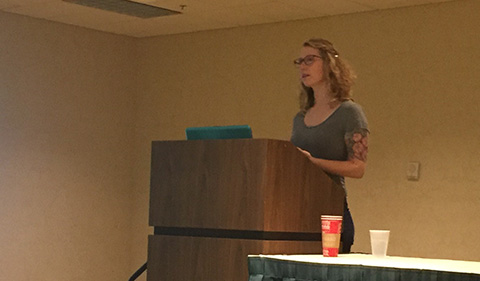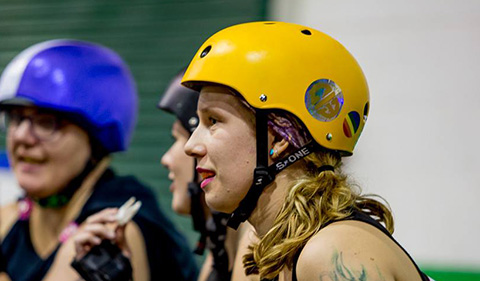
Babz Jewell at American Society of Criminology in November 2016
Babz Jewell, a Sociology master’s student in the College of Arts & Sciences at Ohio University, presented research at the annual meeting of the American Society of Criminology in November.
The paper, “Marked Men: A Photography Study of Veterans Court Participants” was part of a panel on “The Same but Different: Examining Underexamined Types of Problem-Solving Courts.” It was the result of research by Dr. Ursula Castellano, Associate Professor of Sociology.
Jewell has been working since the beginning of the academic year as Project Assistant on Castellano’s broader video project, which was recently featured in A&S Forum, and for which Castellano was recently awarded an Ohio Bar Association Foundation grant.
In Addition to Graduate Study
Before beginning her graduate study in Sociology, Jewell earned her B.A. in Art History from the Honors Tutorial College with a minor in German at Ohio University, then spent time in Germany with a Fulbright Teaching Fellowship, followed by a year of service with AmeriCorps in Athens County.
Outside her scholarly role, Jewell skates with the local Appalachian Hell Betties Roller Derby Team.

Appalachian Hell Betties Roller Derby team member Babz Jewell. Photo Credit: Sallie Sauber
American Society of Criminology
The American Society of Criminology is an international organization whose members pursue scholarly, scientific, and professional knowledge concerning the measurement, etiology, consequences, prevention, control, and treatment of crime and delinquency. The society’s objectives are to encourage the exchange, in a multidisciplinary setting, of those engaged in research, teaching, and practice so as to foster criminology scholarship, and to serve as a forum for the dissemination of criminology knowledge. Membership includes students, practitioners, and academicians from the many fields of criminal justice and criminology.
Problem-Solving Courts
Problem-solving courts (aka specialty courts) have gained prominence since the 1990s. Designed to reflect restorative justice practices, these courts offer an alternative to traditional court processes by linking persons involved in the criminal justice system to services and/or treatment expected to reduce participation in criminal behaviors. Castellano’s research takes a lens to participants within Ohio’s Veterans Treatment Courts, which is the problem-solving court for U.S. veterans that intersects mental health and addiction courts. Castellano uses cutting edge sociological methodologies centered on photographs taken by informants. The photographs are the center of interviews that ask informants to talk about their lives, relationships, and experiences in VTC and military service.
Castellano’s Findings
“It sounds a bit paradoxical, but with images, we can make the invisible visible by inviting participants to share their narratives with images.” Castellano’s paper supports three preliminary findings:
- Contrary to heroic images of military personnel, many men and women struggle before and after enlistment.
- Photos reveal unspoken nature of their injuries that placed them at risk for justice involvement.
- VTCs are successful in reducing recidivism but this study raises the question of whether these courts are addressing these invisible markers.


















Comments